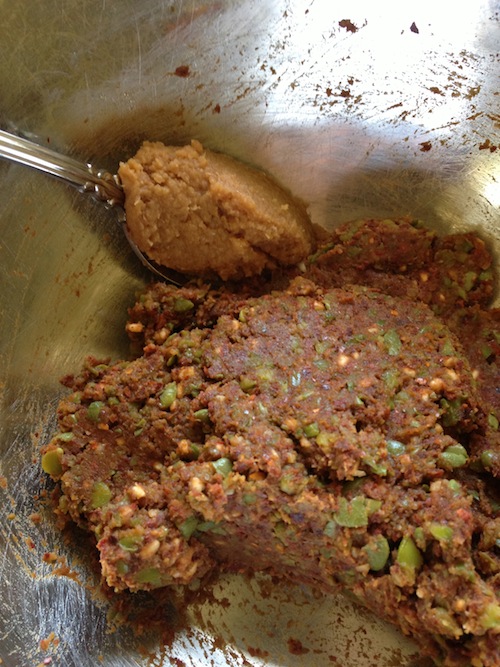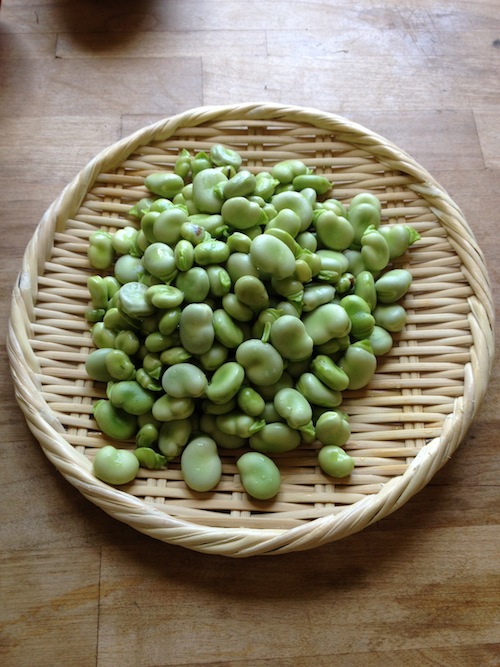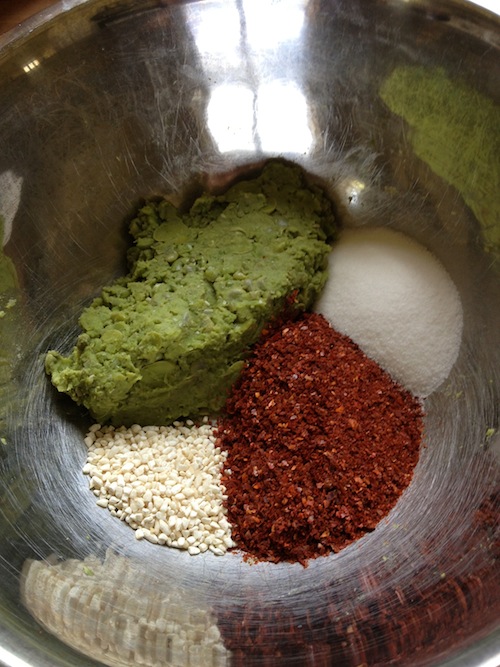
Doubanjiang has been called "the soul of Sichuan cooking." A spicy bean paste most recognizable in Sichuan cuisine, doubanjiang is also a popular ingredient for Japanese home cooking, called
tobanjan.
I use doubanjiang quite often in my cooking for sauces, and I was curious as to how I might make a home-style version using only natural ingredients. I found out that one of the oldest recipes originated in the county of
Pixian in China, and uses fava beans instead of soy beans. Since it is fava bean season now, I wanted to share this recipe with you.
I made my first fava bean doubanjiang last year and was surprised at how great it turned out: wonderful depth of flavor, spicy, sweet, savory and so well-balanced. It has turned my mapo tofu into a force of nature.
INGREDIENTS
1lb. fava beans (shells removed)
2 tbsp
koji (found in Japanese markets)
2.5 tbsp miso
3 tbsp red chili powder
0.25 cup sea salt
1-3 tbsp water
METHOD
1. Remove the shell of fava beans. Keep the skin on the individual beans:

2. Steam fava beans for about 20 minutes:

3. Remove the skin, and mash. Add the koji, red chili powder and sea salt and mix well:

4. Add miso -- you can use any kind but I like
nama-miso (raw miso) is the best. Mix well:

6. For the last step, add water to adjust the texture -- about 1-3 tablespoons -- not to much. Ultimately you want the texture to be like miso. not sauce.

7. Place paste in container, then seal completely on top with plastic wrap. Put some weight on top of the plastic then put the lid on loosely:

8. Let the doubanjiang sit in a dark place, like the pantry room for a month. Then mix the paste well and seal with new plastic wrap, add the weight again, then let it sit for another five months.
When it is ready, it should taste like a spicy miso. Place doubanjiang in the fridge. I am not positive yet but I suspect this will keep for a couple of years, maybe more! But since the ingredients here are all organic and still alive (koji, nama miso), you should check in on it occasionally.
Here are some dishes I have made with the doubanjiang:
 Shrimp with doubanjiang and black bean sauce
Shrimp with doubanjiang and black bean sauce
 Bangbangji (steamed chicken salad)
Bangbangji (steamed chicken salad)
 Miso-sesame-doubanjiang sauce for chilled vegetables and meats
Miso-sesame-doubanjiang sauce for chilled vegetables and meats
 Mapo tofu
Mapo tofu
 Kiriboshi daikon salad
Kiriboshi daikon salad
The addition of this magical paste creates a dynamic quality to countless dishes. Enjoy!
On a sorrowful note, Sichaun was recently struck by a powerful earthquake. There has been considerable damage and loss of life. Our good wishes and prayers go out to the people of Sichuan. Japan knows all too well the destructive power of nature.
*Yuki HD is a Tokyo native with deep roots in izakaya-style home cooking. She currently makes her home in the southwestern United States where the foods of many cultures meet and mingle. Kuishinbo means “enthusiastic eater” in Japanese. Eat up!
 Doubanjiang has been called "the soul of Sichuan cooking." A spicy bean paste most recognizable in Sichuan cuisine, doubanjiang is also a popular ingredient for Japanese home cooking, called tobanjan.
I use doubanjiang quite often in my cooking for sauces, and I was curious as to how I might make a home-style version using only natural ingredients. I found out that one of the oldest recipes originated in the county of Pixian in China, and uses fava beans instead of soy beans. Since it is fava bean season now, I wanted to share this recipe with you.
I made my first fava bean doubanjiang last year and was surprised at how great it turned out: wonderful depth of flavor, spicy, sweet, savory and so well-balanced. It has turned my mapo tofu into a force of nature.
INGREDIENTS
1lb. fava beans (shells removed)
2 tbsp koji (found in Japanese markets)
2.5 tbsp miso
3 tbsp red chili powder
0.25 cup sea salt
1-3 tbsp water
METHOD
1. Remove the shell of fava beans. Keep the skin on the individual beans:
Doubanjiang has been called "the soul of Sichuan cooking." A spicy bean paste most recognizable in Sichuan cuisine, doubanjiang is also a popular ingredient for Japanese home cooking, called tobanjan.
I use doubanjiang quite often in my cooking for sauces, and I was curious as to how I might make a home-style version using only natural ingredients. I found out that one of the oldest recipes originated in the county of Pixian in China, and uses fava beans instead of soy beans. Since it is fava bean season now, I wanted to share this recipe with you.
I made my first fava bean doubanjiang last year and was surprised at how great it turned out: wonderful depth of flavor, spicy, sweet, savory and so well-balanced. It has turned my mapo tofu into a force of nature.
INGREDIENTS
1lb. fava beans (shells removed)
2 tbsp koji (found in Japanese markets)
2.5 tbsp miso
3 tbsp red chili powder
0.25 cup sea salt
1-3 tbsp water
METHOD
1. Remove the shell of fava beans. Keep the skin on the individual beans:
 2. Steam fava beans for about 20 minutes:
2. Steam fava beans for about 20 minutes:
 3. Remove the skin, and mash. Add the koji, red chili powder and sea salt and mix well:
3. Remove the skin, and mash. Add the koji, red chili powder and sea salt and mix well:
 4. Add miso -- you can use any kind but I like nama-miso (raw miso) is the best. Mix well:
4. Add miso -- you can use any kind but I like nama-miso (raw miso) is the best. Mix well:
 6. For the last step, add water to adjust the texture -- about 1-3 tablespoons -- not to much. Ultimately you want the texture to be like miso. not sauce.
6. For the last step, add water to adjust the texture -- about 1-3 tablespoons -- not to much. Ultimately you want the texture to be like miso. not sauce.
 7. Place paste in container, then seal completely on top with plastic wrap. Put some weight on top of the plastic then put the lid on loosely:
7. Place paste in container, then seal completely on top with plastic wrap. Put some weight on top of the plastic then put the lid on loosely:
 8. Let the doubanjiang sit in a dark place, like the pantry room for a month. Then mix the paste well and seal with new plastic wrap, add the weight again, then let it sit for another five months.
When it is ready, it should taste like a spicy miso. Place doubanjiang in the fridge. I am not positive yet but I suspect this will keep for a couple of years, maybe more! But since the ingredients here are all organic and still alive (koji, nama miso), you should check in on it occasionally.
Here are some dishes I have made with the doubanjiang:
8. Let the doubanjiang sit in a dark place, like the pantry room for a month. Then mix the paste well and seal with new plastic wrap, add the weight again, then let it sit for another five months.
When it is ready, it should taste like a spicy miso. Place doubanjiang in the fridge. I am not positive yet but I suspect this will keep for a couple of years, maybe more! But since the ingredients here are all organic and still alive (koji, nama miso), you should check in on it occasionally.
Here are some dishes I have made with the doubanjiang:
 Shrimp with doubanjiang and black bean sauce
Shrimp with doubanjiang and black bean sauce
 Bangbangji (steamed chicken salad)
Bangbangji (steamed chicken salad)
 Miso-sesame-doubanjiang sauce for chilled vegetables and meats
Miso-sesame-doubanjiang sauce for chilled vegetables and meats
 Mapo tofu
Mapo tofu
 Kiriboshi daikon salad
The addition of this magical paste creates a dynamic quality to countless dishes. Enjoy!
On a sorrowful note, Sichaun was recently struck by a powerful earthquake. There has been considerable damage and loss of life. Our good wishes and prayers go out to the people of Sichuan. Japan knows all too well the destructive power of nature.
*Yuki HD is a Tokyo native with deep roots in izakaya-style home cooking. She currently makes her home in the southwestern United States where the foods of many cultures meet and mingle. Kuishinbo means “enthusiastic eater” in Japanese. Eat up!
Kiriboshi daikon salad
The addition of this magical paste creates a dynamic quality to countless dishes. Enjoy!
On a sorrowful note, Sichaun was recently struck by a powerful earthquake. There has been considerable damage and loss of life. Our good wishes and prayers go out to the people of Sichuan. Japan knows all too well the destructive power of nature.
*Yuki HD is a Tokyo native with deep roots in izakaya-style home cooking. She currently makes her home in the southwestern United States where the foods of many cultures meet and mingle. Kuishinbo means “enthusiastic eater” in Japanese. Eat up!




Comments (3)
This looks fun to make. I am a huge fan of spice, so this is enticing. It will be hard to resist the urge to eat some during the 6 months of maturity.
I always thought tobanjan came from a jar so it’s really impressive that you made it at home. And it’s so versatile too.
Your jam must be delicious, but its not Pixian Doubanjiang, you may used the way of Northern China Bean Jam, not Sichuan Doubanjiang.Sichuan doubanjiang need yeasty fava beans(very hard to make in foreign countries), together with fresh red chili, ginger, garlic, salt,Chinese red pepper etc., stur, put in a clean jar,storage, or bask in the sun cover with glass,anyway, let it ferment. I love your site, but just have to say somthing as a Chinese, ha:-P.